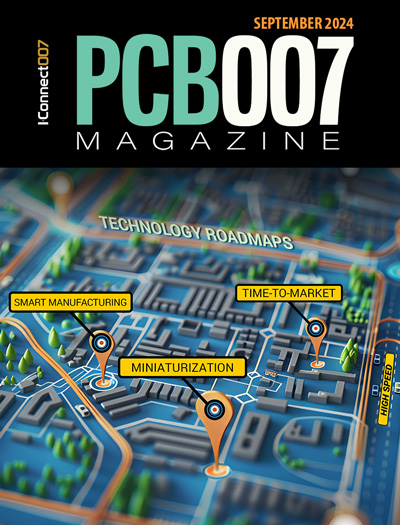-

- News
- Books
Featured Books
- pcb007 Magazine
Latest Issues
Current Issue
Engineering Economics
The real cost to manufacture a PCB encompasses everything that goes into making the product: the materials and other value-added supplies, machine and personnel costs, and most importantly, your quality. A hard look at real costs seems wholly appropriate.

Alternate Metallization Processes
Traditional electroless copper and electroless copper immersion gold have been primary PCB plating methods for decades. But alternative plating metals and processes have been introduced over the past few years as miniaturization and advanced packaging continue to develop.

Technology Roadmaps
In this issue of PCB007 Magazine, we discuss technology roadmaps and what they mean for our businesses, providing context to the all-important question: What is my company’s technology roadmap?
- Articles
- Columns
Search Console
- Links
- Media kit
||| MENU - pcb007 Magazine
Microsatellite Project to Monitor Objects in Space Over Canada, South Pole
October 11, 2024 | BUSINESS WIREEstimated reading time: 3 minutes
An exciting new satellite project to monitor and protect the Earth’s orbital environment is underway. University of Manitoba (UM) and Magellan Aerospace (Magellan), in collaboration with Canada’s Department of National Defence (DND) science and technology organization, Defence Research and Development Canada (DRDC), and the United Kingdom’s Defence Science and Technology Laboratory (Dstl), are working together to make it a reality.
“With new launch companies providing unprecedented access to space, we need to research and develop new ways of monitoring space objects from small spacecraft to prevent collisions and to maintain space sustainability for the entire planet. This is a challenge of global scale, requiring international collaboration between industry and academia,” says Philip Ferguson, Associate Professor, Department of Mechanical Engineering and lead of UM’s Space Technology and Advanced Research Laboratory (STARLab).
Magellan and UM, both based in Winnipeg, Manitoba, are currently partnered on the DND-funded Redwing space domain awareness microsatellite project. Redwing is a research and development (R&D) microsatellite valued at $15.8 million, that is being designed, built, and operated in Canada. Redwing will monitor objects orbiting Earth to help reduce future risks to Canada’s space infrastructure from space debris or human-caused interference. Magellan is responsible for designing, building, and testing the Redwing spacecraft as well as for mission operations. Other Redwing mission partners include ABB Inc (main optical payload), C-CORE (operations support), as well as York University and UM (R&D support).
In April 2024, Canada’s DND signed a contract option with Magellan for $900,000 to add a companion nanosatellite to the Redwing mission. The nanosatellite, known as Little Innovator in Space Situational Awareness (LISSA), will be integrated with the Redwing satellite and will be deployed from Redwing sometime after launch, once the two spacecraft have achieved an orbit at the designated altitude.
“Collaborations between industry, academia, and government are the foundation of innovation in the space sector. These partnerships merge cutting-edge research with industry expertise, accelerating advancements that will shape the future of space exploration and will cultivate the next generation of space professionals. By working together on LISSA and Redwing, we can yield superior results in space domain awareness that would be impossible in isolation,” says Corey Mack, Magellan’s Director of Engineering and Space Systems.
Leveraging the expertise provided by Ferguson and UM’s STARLab, Magellan is contracting the design and build of LISSA with UM. LISSA will follow in the same orbit as Redwing, operating some distance from it in a tandem in-track formation. In addition to performing its own observations, LISSA will serve as a convenient nearby object with which to exercise Redwing’s own monitoring and imaging capabilities.
“The space domain continues to change and evolve and requires space faring nations to innovate to keep informed of the security situation in the space domain. DRDC is thrilled to have Dstl participate in the Redwing mission to help grow both nations’ defence space programs,” said Scott McLelland, DRDC Director of R&D for the Defend North America strategic focus area.
LISSA will focus on observing satellites as they pass over the Earth’s South Pole, a region that is not well-covered by ground-based space surveillance sensors. Reflected light from ice and clouds during the Antarctic summer presents a significant technical challenge when imaging other space objects in visible light. For this reason, the UK’s Dstl is providing a short-wave infrared camera to be hosted on the LISSA nanosatellite, which will be less impacted by light scattered from the ice sheet. Also, many satellite materials are more reflective in the short-wave infrared increasing the likelihood of detecting them.
“The collaboration with our Canadian partners will enable us to improve the characterisation of objects and maintain security in space to protect our mutual interests,” says Dr. Gemma Bagheri, Dstl Space Research and Development Programme Manager.
Both Redwing and LISSA are expected to launch in 2027. Both satellites will be operated by Magellan with support from UM’s STARLab, communicating through ground antenna stations owned by C-CORE in Inuvik, Northwest Territories and Happy Valley-Goose Bay, Newfoundland and Labrador. Mission data will be analyzed by DRDC and Dstl.
“Research partnerships are critical to the future of the global space industry. This project between the UM, Magellan, DND, and Dstl will create sustainable technologies for the next generation of satellite missions,” adds Phil Ferguson.
Suggested Items
PI's New Expansion for Higher Electronics Manufacturing Capacities and Shorter Lead Times
11/20/2024 | PRNewswirePI, the market and technology leader for high-precision motion control, positioning technology, and piezo applications, has completed the construction of additional electronics production space at its Rosenheim, Germany site.
Orbex Welcomes Contract Extension and Additional Funding from ESA’s Boost! Programme
11/19/2024 | OrbexLeading orbital launch services company, Orbex has today welcomed the extension of its contract with the European Space Agency’s (ESA) Boost! Programme and additional funding of €5.6 million.
L3Harris Delivers Optical System to NASA for Nancy Grace Roman Space Telescope
11/19/2024 | L3Harris TechnologiesL3Harris Technologies has delivered the Optical Telescope Assembly (OTA) to NASA that serves as the critical “eye” for the Nancy Grace Roman Space Telescope by providing precise and stable imagery.
NRL Completes Development of Robotics Capable of Servicing Satellites, Enabling Resilience for the U.S. Space Infrastructure
11/18/2024 | NRLU.S. Naval Research Laboratory (NRL) Naval Center for Space Technology (NCST) in partnership with Defense Advanced Research Projects Agency (DARPA) successfully completed development of a spaceflight qualified robotics suite capable of servicing satellites in orbit, Oct. 8.
RTX's Raytheon Awarded U.S. Army Contract for Wireless Power Beaming Technology
11/18/2024 | Raytheon TechnologiesRaytheon, an RTX, has been awarded a contract from the U.S. Army to work on directed energy wireless power beaming capabilities that will distribute power across the battlefield, simplify logistics, and safeguard locations for U.S. troops.


